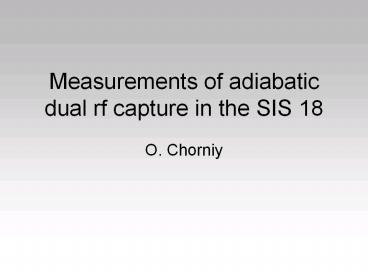Measurements of adiabatic dual rf capture in the SIS 18 PowerPoint PPT Presentation
1 / 21
Title: Measurements of adiabatic dual rf capture in the SIS 18
1
Measurements of adiabatic dual rf capture in the
SIS 18
- O. Chorniy
2
Contents
- Introduction
- Dual harmonic rf capture, scheme 1
- Dual harmonic rf capture, scheme 2
- Single rf capture
- Summary and Outlook
3
Introduction
- In dual harmonic rf bucket (in comparison with
single harmonic rf bucket) - The flat voltage leads to a longer bunch. RF
bucket area is larger then for single harmonic.
It reduces maximum density in the bucket center. - Bunch in a dual rf bucket is more stable.
Nonlinearity created by dual harmonic rf bucket
increases Landau damping.
Dual harmonic rf signal
4
Dual harmonic rf capture, scheme 1
5
Dual harmonic rf capture, scheme 1
Fixed rf capture for different intensities
RF cavity (h8)
SIS
Pickup
RF cavity (h4)
RF amplitude ramps for different harmonics starts
with time delay
Features of the measurements Constant
(injection) energy Ion Intensity, part.
6
Diagnostics in time and frequency domain
Longitudinal beam profile measurements
Longitudinal schottky measurements
7
Longitudinal bunch profiles in a single and dual
rf buckets
Maxwell-Boltzmann beam profile
RF potential in general form
- represent rms bunch
- length for short bunches
Dual harmonics rf
Single harmonic rf
8
Longitudinal bunch spectrum in a single and dual
rf buckets
From bunch spectra in a single rf bucket
From bunch spectra in a dual rf bucket
Synchrotron frequencies should be equal
expected
9
Longitudinal bunch profiles at different
intensities
One of the reasons for the bunch lengthening can
be increase of momentum spread at injection.
Another reason can be the mismatch of rf
frequency.
10
Momentum spread of the injected coasting beam at
different intensities
Low intensity momentum spread
High intensity momentum spread
Thus the emittance (and as a result, bunch
length) may grow due to filamentation of the part
of momentum spread which is not matched with
synchronous energy
11
Dilution factor
Longitudinal phase space before and after rf
capture
Bunch profile (dual rf bucket)
Schottky spectra
Dilution factor
dilution factor (experiments) dilution factor
(ESME result)
The dilution factor was calculated for lowest
intensity
12
Dual harmonic rf capture, scheme 2
13
Dual harmonic rf capture, scheme 2
Different rf capture times for fixed intensity
Features of the measurements Constant
intensity Capture time
Amplitude ramps for different harmonics starts
simultaneously
Momentum spread
14
Capture efficiency at different capture times
Measured Dilution factor
Emittance increase by factor of 2 even for
adiabatic times.
Short capturing time influences noise in the
stationary bunch form. Possible explanation
mismatch of rf frequency.
200ms
50ms
10ms
15
Comparison with simulation results
Simulations (ESME)
Experiment (SIS) vs simulations (ESME)
A significant deviation of the simulation
results from the measurements was found The
difference cannot be explained by the error in
the value of the initial voltage Simulation
results provide us the value of frequency
mismatch of 500 Hz
16
Dilution factor vs initial conditions
Phase space, coasting beam
Simulation results for different ions (done by
T. Shukla)
initial rf bucket
Initial conditions can be described by
In process Analytic description of the curve
Dilution factor( )
17
Comparison between the different dual harmonics
rf capture schemes
Bunch waterfall plot in the case of rf capture
with delay between harmonics
Bunch waterfall plot in the case of rf capture
without delay between harmonics
Bunch length 206 deg
Bunch length 218 deg
Measurements at high intensity Long capture
time 100-200 ms
18
Single rf capture results
19
RF capture in single rf bucket
Almost constant bunch length for all capture
times.
Capturing time has influence on the presence of
persistent longitudinal oscillations (in dual
harmonics rf scheme only small noise).
200 ms
100 ms
10 ms
20
Spectra of the bunch in single rf bucket
Beam spectra
Synchrotron frequency Dipole frequency Frequency
of persistent oscillations
Do we expect similar strong longitudinal
oscillations in dual rf bucket at higher
intensities? Will it lead to instabilities? (Futur
e work)
Oscillations cannot be damped by dipole feedback
system.
21
Conclusions
- To save the machine cycle time both harmonics can
start at the same time. - Dilution factor can be reduced by rf capture at
different rf frequencies. - For the intensity of 1010 ramping time can be
down to 20-50 ms (only for dual rf harmonics
regime) - Dual rf capture experimental studies will be
continued for higher intensities

